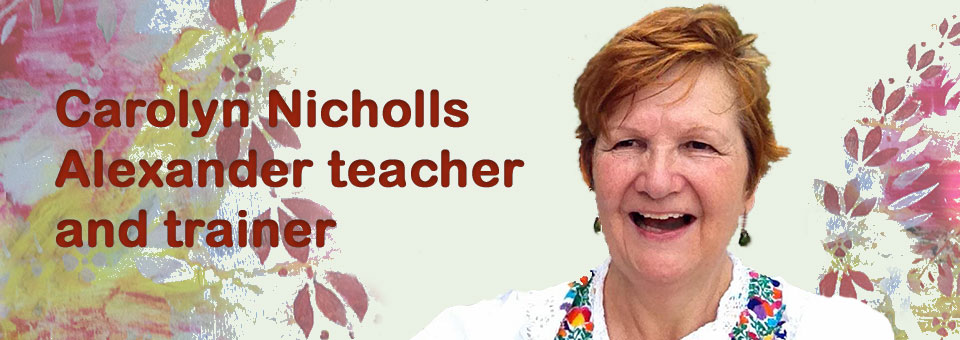Notes on the work of Dilys Carrington
You can buy my book about my work with Dilys .
I first met Dilys in 1977 when I became interested in training at the Constructive Teaching Centre and had private lessons with Dilys. I enjoyed my lessons hugely and found Dilys’s approach both practical and refreshing. She was interested in everything I did and showed me inventive ways to apply directions to my T’ai Chi practice as well as discussing recipes and the physical act of beating pancake batter! (don’t beat the mixture with your jaw muscles…)
When I started training in 1979 Dilys was running the first 4 terms of the training course and taking all us students for regular hands-on groups. The skill of training people to use their hands well was something Dilys was passionate about and she felt that when people first started training they had little idea of how to direct their own use. “They don’t really understand direction,” was how she put it.
Dilys set out to remedy this in her hands-on groups by addressing the fundamental skills that underlie good use of the hands. So new trainees spent their groups being put through monkey after monkey, learning to release arms and legs without collapsing in the back, learning to take weight through their arms without tightening their chests and shoulders and how to rotate their forearms without grabbing with their hands and fingers. All of this was done under Dilys’s expert and accurate hands. She was very precise about direction and easily able to stimulate release and undoing in us students. It was common after a group with Dilys to find a quiet corner to lie down in to recover from what seemed like a thorough workout.
Dilys was also a keen needlewoman and delighted in tapestry designs for the many ‘drop in’ seat covers of the beautiful Victorian chairs that were around the house. I had previously studied textiles and embroidery and would discuss designs with Dilys-she loved the traditional designs of fruit and flowers and once stitched a matching set of six covers for a set of chairs she and Walter owned. These were on a black background-which is a difficult colour to work well as if you accidentally twist the wool whilst working the shade of black differs over the design . If you can’t keep your tension even as you work you end up with a motley finish. For Dilys, this too was a mater of good use and direction.
I was fortunate enough to be Dilys’ first apprentice in the remarkable skill of teaching hands–on skills. I spent a year with her, working with a group of trainees from their first group all the way through the first year of their training. I was so fascinated by Dily’s approach that I documented the whole thing and produced a document entitled “Notes Towards a Method of Training Alexander Teachers; an observation of Dilys Carrington”. At every stage Dilys and I would discuss what I had written and she would suggest changes to wording. I spent many happy times in Dily’s flat upstairs asking her many questions about what she was teaching, the how and the why-all interspersed with cups of tea and discussion about her latest tapestry design or where she and Walter were travelling to next.
Dilys was s true pioneer and her work with hands on skills was of immense value. It formed the basis of many training courses both in the UK and overseas. When John Nicholls and I emigrated to Australia to run a training course in Melbourne, it was Dily’s approach to hands-on work that underpinned our methods. She and Walter came out to Australia to visit us and I had the pleasure of showing Dilys how our students were coming along using her approach. She was as always, enthusiastic, delightful and warm hearted about it. She also wanted to visit the local market to look at textiles and maybe pick up a new tapestry design with an Australian twist to it!
Fifteen years after I wrote “Notes” I undertook a masters study looking at the unique skill of using your hands as an Alexander teacher. I was able to go back to Dilys and have more discussion with her about her work-how it had changed over the years, and what was timeless about the work. As always Dilys was interested in what I was doing first-we still discussed embroidery and our children as well as sipping tea and talking about ‘the work’. She had written some more papers on spirals and gave me copies. Dilys was the most delightful woman and made a unique contribution to understanding direction in teaching. I can do no better than to quote her words.
